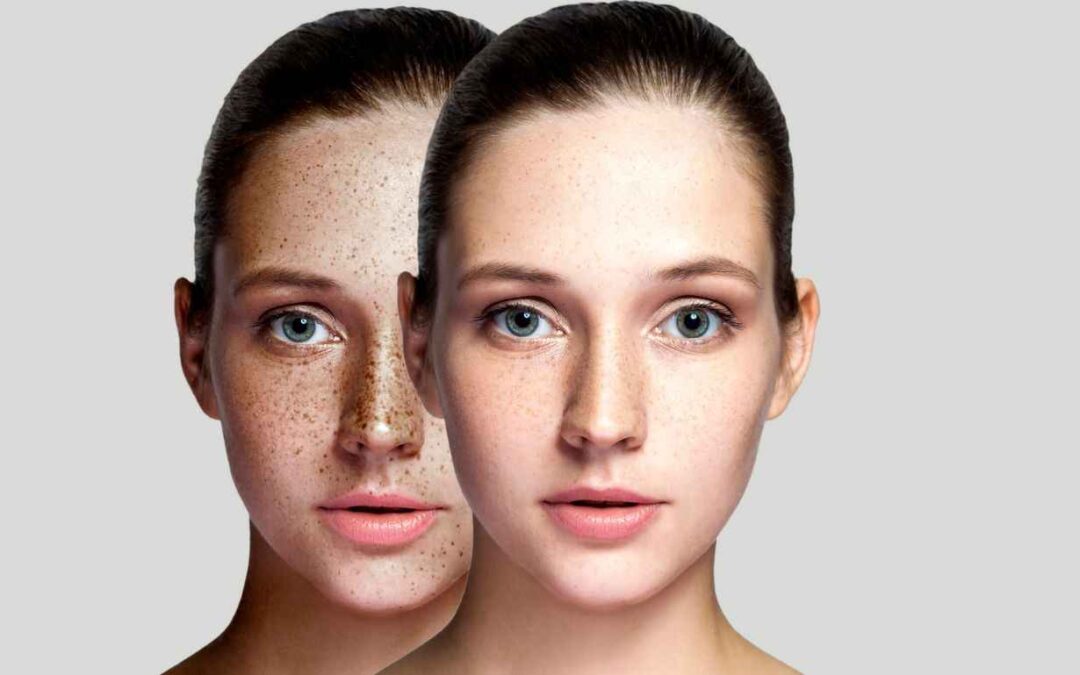Freckles are small brown spots on the skin that typically appear in areas exposed to the sun, such as the face and hands. While generally harmless, some individuals may seek to minimize their appearance for aesthetic reasons. This article explores practical solutions for managing freckles, covering both preventive measures and treatment options.
Contents
ToggleWhat Are Freckles?
Freckles result from the overproduction of melanin, the pigment responsible for skin and hair color. There are two primary types:
- Ephelides: These are the common freckles that appear during childhood due to sun exposure and typically fade with age.
- Solar Lentigines, also known as age spots or sunspots, appear later in life and persist over time.
Genetics and environmental factors, such as ultraviolet (UV) radiation, influence both types.
Causes of Freckles
Freckles are largely hereditary, with the MC1R gene playing a significant role. However, external factors like sun exposure also contribute to their development. Those with lighter skin tones or red and blonde hair are more prone to freckles due to their lower levels of UV-protective eumelanin.
Differences Between Freckles and Other Skin Conditions
Freckles vs. Sunspots
- Freckles: Appear early in life, often fade with reduced sun exposure, and are small (1–2 mm).
- Sunspots: Appear later in life, remain constant regardless of seasons, and are larger (2 mm or more).
Freckles vs. Moles
- Moles: Result from an excess of pigment-forming cells and may indicate an increased risk of melanoma. Freckles, on the other hand, pose no such threat.
Prevention: Protecting Your Skin
The best way to manage freckles is by preventing them from forming in the first place.
Daily Sunscreen Use
Apply a broad-spectrum, water-resistant sunscreen with an SPF of at least 30 every day, regardless of the weather. Sunscreen not only prevents freckles but also reduces the risk of skin cancer.
Minimize Sun Exposure
- Avoid prolonged exposure during peak UV hours (10 a.m. to 4 p.m.).
- Wear protective clothing, wide-brimmed hats, and sunglasses.
Treatment Options for Freckles
While freckles are harmless, several options can help lighten or remove them:
1. Over-the-Counter Products
Certain topical treatments can reduce freckles, including:
- Alpha Hydroxy Acids (AHAs): Gently exfoliate the skin and reduce pigmentation.
- Chemical Peels: Formulations like Jessner Solution can effectively lighten freckles. Always follow instructions carefully to avoid irritation.
2. Prescription Creams
Dermatologists may recommend products containing:
- Hydroquinone: A skin-lightening agent that reduces melanin production.
- Retinoids: Enhance skin renewal and reduce pigmentation over time.
3. Laser Therapy
Fractionated resurfacing lasers target pigmented cells, helping to fade freckles and stimulate collagen production. These treatments can be effective for both ephelides and solar lentigines.
Advanced Techniques: Exploring Challenges
When selecting a treatment, consider the following trade-offs:
- Efficacy vs. Safety: While lasers provide quick results, they may cause temporary redness or swelling.
- Cost vs. Accessibility: Professional treatments like laser therapy can be expensive, whereas over-the-counter products are more affordable but slower to show results.
The Role of Genetics
While environmental factors play a role, genetics significantly influence freckle formation. Those with the MC1R gene are predisposed to developing freckles. However, even individuals with a genetic tendency can reduce their appearance with proper skin care and sun protection.
Monitoring Your Skin
Regularly check your freckles and moles using the ABCDE rule to identify any concerning changes:
- Asymmetry: Uneven halves may indicate an issue.
- Border: Irregular edges could signal a problem.
- Color: Multiple colors in one spot warrant attention.
- Diameter: Larger than ¼ inch may require evaluation.
- Evolving: Any changes in size, shape, or texture should be assessed by a dermatologist.
When to Consult a Dermatologist
If you notice any unusual changes in your freckles or moles, schedule a dermatological exam. Annual screenings are especially important for individuals with fair skin, numerous moles, or a history of excessive sun exposure.
Final Thoughts
Freckles are a natural and often beautiful feature, but they can be minimized with proper care and treatment if desired. By combining preventive measures like sunscreen with targeted treatments, you can manage freckles effectively while maintaining healthy skin. Always consult a dermatologist before starting new treatments to ensure safety and optimal results.
